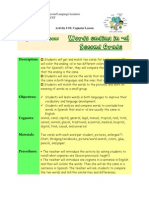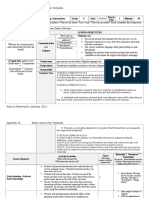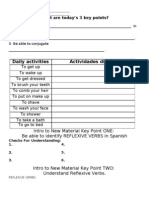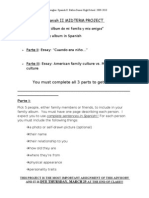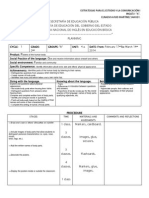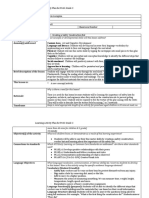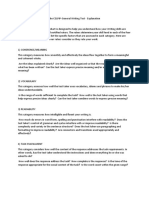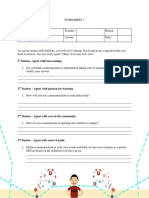Esl Siop Spanish
Esl Siop Spanish
Uploaded by
api-246223007Copyright:
Available Formats
Esl Siop Spanish
Esl Siop Spanish
Uploaded by
api-246223007Original Title
Copyright
Available Formats
Share this document
Did you find this document useful?
Is this content inappropriate?
Copyright:
Available Formats
Esl Siop Spanish
Esl Siop Spanish
Uploaded by
api-246223007Copyright:
Available Formats
SIOP Lesson Plan Template 2
STANDARDS: THEME: LESSON TOPIC: Spanish Numbers and Colors OBJECTIVES: Language:
The students will be able to speak the Spanish words and use them in class discussion
Content:
The students will be able to identify numbers one through five in Spanish The students will be able to identify the colors red, orange, yellow, green and blue in Spanish
LEARNING STRATEGIES: repetition, modeling, guided practice, group work KEY VOCABULARY: uno, dos, tres, cuatro, cinco, rojo, naranja, amarillo, verde, azul MATERIALS: chalkboard, crayons, worksheet, objects around the classroom, word cards MOTIVATION:
(Building background) Thet teachers will ask the students if they have ever heard of Spanish. Natasha will speak some Spanish words such as: school, recess, snack (other important words to Kindergarteners). The teachers will write the objectives on the board and will explain that today we are going to learn numbers 1-5 and colors of the rainbow in Spanish. First, the teachers will review the colors and numbers in English. "Someone hold up two fingers for us" "Who can take out their red crayon for us" for the numbers 1-5 and all colors that are to be taught in Spanish.
PRESENTATION:
(Language and content objectives, comprehensible input, strategies, interaction, feedback) After building background, the teachers will explain that the students have to listen very carefully to the teachers because they will hear words that they might not know and they have to use listening ears to learn the words. Becca will say "one," Natasha will say "uno." The children will hold up one finger and say "uno." This will continue for the numbers 1-5. The teachers will then review all five numbers in order, while the students are holding up their fingers indicating 1, 2, 3, 4 or 5. The teachers will then say that we are going to learn the colors red, orange, yellow, green and blue in Spanish. Becca will say "red," and Natasha will say "rojo." While saying red, Becca will hold up a piece of red paper saying "red" and Natasha will hold up a piece of red paper saying "rojo." The children will repeat the words with the teachers. This routine will continue for all five color words. The students will hold up their crayons that correspond with the corect color for reinforcement. The teachers will then review the numbers and colors in Spanish before seperating into groups for the activity.
2008 Pearson Education, Inc.
SIOP Lesson Plan Template 2
PRACTICE AND APPLICATION: (Meaningful activities, interaction, strategies, practice and application, feedback)
The teachers will model the activity for the students. Natasha will say, "Becca can you color in tres smiley faces amarillo?" Becca will say " I know that tres means three, and I think that amarillo means yellow. If I am not sure I will ask Miss Natasha. So I will take my yellow crayon and color in one, two, three smiley faces, while staying in the lines." Then, I will watch as another one of my friends in my group colors their smiley faces. Does everyone understand?" The students will split up into two groups. Natasha will take one group and Becca will take the other. The students will bring their crayon box with them and will receive the worksheet. Each child will receive a different direction to assess their knowledge of the numbers and colors in Spanish. The teachers will guide the students and will look back at the color word cards if necessary, or the help of counting on their fingers.
REVIEW AND ASSESSMENT: (Review objectives and vocabulary, assess learning)
The students will come back to their seats. The teachers will ask students to raise their hand if they can remember how many smiley faces they colored on their paper and what color they are. If the students need help, they will be guided by the teachers. Then, the teachers will review all of the vocabulary words and what they mean.
EXTENSION:
If there is more time in the groups, the students will be asked to point out different colors around the room, using Spanish words. The teacher can also review numbers by counting on their fingers or asking questions such as "how many days are in the week?"
(Reproduction of this material is restricted to use with Echevarria, Vogt, and Short, 2008. Making Content Comprehensible for English Learners: The SIOP Model.)
2008 Pearson Education, Inc.
You might also like
- Repaso-I 31.3.2021Document93 pagesRepaso-I 31.3.2021riya bhati100% (2)
- Lesson Plan WeeblyDocument12 pagesLesson Plan Weeblyapi-281027473100% (1)
- Totally True, Book ReviewDocument4 pagesTotally True, Book ReviewDublinCentreofTESOL100% (1)
- Fellow Teacher Recommendation Letter 7Document1 pageFellow Teacher Recommendation Letter 7AL Johnedel Guillermo AcioNo ratings yet
- Activity 10 Cognate Lesson PlanDocument4 pagesActivity 10 Cognate Lesson Planapi-256385167No ratings yet
- Lesson Plan El Presente PerfectoDocument10 pagesLesson Plan El Presente Perfectoapi-323597478No ratings yet
- Lesson Plan SaludosDocument1 pageLesson Plan SaludosAnthony Jan CabaticNo ratings yet
- Spanish 2 SyllabusDocument4 pagesSpanish 2 SyllabusJoaquinNo ratings yet
- Lesson Plan 11 4 Dar ConsejosDocument6 pagesLesson Plan 11 4 Dar Consejosapi-314623879No ratings yet
- Spanish Lesson Plan FinalDocument2 pagesSpanish Lesson Plan Finalapi-511008041No ratings yet
- Spanish Lesson Plans September 19-30Document4 pagesSpanish Lesson Plans September 19-30api-329930604100% (1)
- Aspiration PronunciationDocument3 pagesAspiration PronunciationElsa Vargas Monter100% (1)
- Lesson Plan Spanish Act WeeblyDocument3 pagesLesson Plan Spanish Act Weeblyapi-279503407100% (1)
- Lesson 5 FinalDocument4 pagesLesson 5 Finalapi-301154896No ratings yet
- Complete Unit PlanDocument18 pagesComplete Unit Planapi-268989441No ratings yet
- Class: Upla Final Practicum Supervise Teacher: Isabel Vásquez School: Liceo Tecnico-Profesional Barón Class: 1º F of Secondary School Year: 2009Document33 pagesClass: Upla Final Practicum Supervise Teacher: Isabel Vásquez School: Liceo Tecnico-Profesional Barón Class: 1º F of Secondary School Year: 2009dambep2139100% (2)
- Lesson Plan: La FamiliaDocument11 pagesLesson Plan: La FamiliaDonna JohnsonNo ratings yet
- FL Observation FormDocument2 pagesFL Observation FormElizabeth Dentlinger100% (4)
- Cap 3 - Spanish Shopping ProjectDocument1 pageCap 3 - Spanish Shopping Projectmbr91853285100% (1)
- Examples of Rubric S November 2013Document22 pagesExamples of Rubric S November 2013Ruqayyah RahimNo ratings yet
- Danielson Framework For Novice TeacherDocument3 pagesDanielson Framework For Novice Teacherapi-329930604No ratings yet
- Ser and Estar Lesson PlanDocument2 pagesSer and Estar Lesson Planapi-242143141No ratings yet
- Mined Lesson Plan SampleDocument1 pageMined Lesson Plan SampleKROSDEVIL505No ratings yet
- Lesson 6 - Personal PronounsDocument2 pagesLesson 6 - Personal Pronounsapi-346214304No ratings yet
- Numbers Lesson PlanDocument3 pagesNumbers Lesson Planmariody100% (1)
- Lesson Planning Form For Accessible Instruction - Calvin College Education ProgramDocument4 pagesLesson Planning Form For Accessible Instruction - Calvin College Education Programapi-336528722No ratings yet
- CSUF ELD-M LessonPlanTemplate-Lesson 2Document3 pagesCSUF ELD-M LessonPlanTemplate-Lesson 2CNo ratings yet
- Inclusion Lesson PlanDocument5 pagesInclusion Lesson Planapi-532813028No ratings yet
- Interchange UDocument7 pagesInterchange UNick SandersonNo ratings yet
- Cuadernillo Present SimpleDocument3 pagesCuadernillo Present SimpleMarianela LeonardelliNo ratings yet
- Spanish 1 SyllabusDocument5 pagesSpanish 1 Syllabusapi-292061675No ratings yet
- Designing Meaningful Performance Based AssessmentDocument19 pagesDesigning Meaningful Performance Based AssessmentMylen JuntoriaNo ratings yet
- CN Reflexive VerbsDocument6 pagesCN Reflexive VerbsJoaquinNo ratings yet
- Write in The Correct Verb To Be: Re-Arrange The SentenceDocument7 pagesWrite in The Correct Verb To Be: Re-Arrange The Sentencedreamer47920No ratings yet
- 3 - Numbers-1-10-Lesson-PlanDocument6 pages3 - Numbers-1-10-Lesson-PlanRicardo BasurtoNo ratings yet
- Taxonomy of Language Teaching TechniquesDocument3 pagesTaxonomy of Language Teaching TechniquesThái An NguyễnNo ratings yet
- Actfl Spanish ActivitiesDocument16 pagesActfl Spanish Activitiesapi-238799032No ratings yet
- Spanish Question Word TeaserDocument6 pagesSpanish Question Word TeaserJosé Ricardo GarcíaNo ratings yet
- Spanish1 Ms Term4Document8 pagesSpanish1 Ms Term4api-264184239No ratings yet
- Lesson Plan Fruits and Vegetables 1er GradoDocument8 pagesLesson Plan Fruits and Vegetables 1er GradomarluzmaresNo ratings yet
- WEEK 2 Lecture Syllabus DesignDocument39 pagesWEEK 2 Lecture Syllabus DesignLee Kean WahNo ratings yet
- Lesson PlanDocument5 pagesLesson Planapi-290537330No ratings yet
- Cooperative Learning Lesson Plan CompleteDocument2 pagesCooperative Learning Lesson Plan Completeapi-458189550No ratings yet
- Spanish Verbs SER and ESTARDocument4 pagesSpanish Verbs SER and ESTARdwels002No ratings yet
- El Encierro de Toros Unit PlanDocument11 pagesEl Encierro de Toros Unit Planapi-340824562No ratings yet
- PPP Lesson Plan Hobbies There Is There AreDocument4 pagesPPP Lesson Plan Hobbies There Is There Areapi-267290342No ratings yet
- NOTES - Subject PronounDocument2 pagesNOTES - Subject PronounJoaquin100% (1)
- SPANISH 1, Sem 2 (Avancemos) - Course Guide / Syllabus / Lesson Plans - by Marty J ReepDocument4 pagesSPANISH 1, Sem 2 (Avancemos) - Course Guide / Syllabus / Lesson Plans - by Marty J ReepMarty Reep50% (2)
- Spanish II MIDTERM PROJECT Family AlbumDocument3 pagesSpanish II MIDTERM PROJECT Family AlbumJoaquinNo ratings yet
- ImperativeDocument2 pagesImperativeTanjaNo ratings yet
- Kelsey Winkel Lesson Plan : Warm - Up / Calentamiento 5 MinDocument5 pagesKelsey Winkel Lesson Plan : Warm - Up / Calentamiento 5 MinamandamazzioNo ratings yet
- Lesson PlanDocument19 pagesLesson PlanJoy DePazNo ratings yet
- SIOP Lesson SampleDocument1 pageSIOP Lesson SampleMarianNo ratings yet
- Spanish Syllabus - MRDocument3 pagesSpanish Syllabus - MRJoaquinNo ratings yet
- Formato de Planeacion de Clase de Ingles MejoradoDocument2 pagesFormato de Planeacion de Clase de Ingles MejoradoMajeaMartinezNo ratings yet
- Silvia Aucapina Ecc 703 Lesson Plan 1Document6 pagesSilvia Aucapina Ecc 703 Lesson Plan 1api-667975246No ratings yet
- Spanish Lesson Plan 1Document3 pagesSpanish Lesson Plan 1api-274021245No ratings yet
- La Familia Parte IIDocument4 pagesLa Familia Parte IIapi-250549495No ratings yet
- Avancemos Unidad 1.1.Document15 pagesAvancemos Unidad 1.1.marsol1982No ratings yet
- LESSON - PLAN - DIANA (1) Spanish LessonDocument4 pagesLESSON - PLAN - DIANA (1) Spanish LessonSelenaNo ratings yet
- Siop Spanish 1Document3 pagesSiop Spanish 1api-202003924No ratings yet
- Unit 2 KindergartenDocument1 pageUnit 2 Kindergartenapi-273417917No ratings yet
- Second Language Acquisiton: Lourdes Ortega By: Eduardo Alberto Alejandra DuránDocument17 pagesSecond Language Acquisiton: Lourdes Ortega By: Eduardo Alberto Alejandra DuránEduardo AlbertoNo ratings yet
- Grammar Possessive Pronouns, Whose 2 - Modo Informe - Unit 10 Lesson 2 - Coursename - MyEnglishLab PDF Morphology LanguageDocument1 pageGrammar Possessive Pronouns, Whose 2 - Modo Informe - Unit 10 Lesson 2 - Coursename - MyEnglishLab PDF Morphology LanguageJulieta Rivera75% (4)
- Recommendation Letter - AFS Global STEM AcademiesDocument2 pagesRecommendation Letter - AFS Global STEM AcademiesKorowodNo ratings yet
- Grade 7 2nd Half 1st QuarterDocument1 pageGrade 7 2nd Half 1st QuarterJohn Rex Garcia PogoyNo ratings yet
- Lista SwadeshDocument27 pagesLista SwadeshCandy Milagros Angulo PandoNo ratings yet
- Cambridge IGCSE ™: English As A Second Language 0510/21Document10 pagesCambridge IGCSE ™: English As A Second Language 0510/21界洋美語No ratings yet
- Celpip Writing SamplesDocument5 pagesCelpip Writing SamplesMaDeline Rosario64% (11)
- Unit 4 Celebrations ADocument50 pagesUnit 4 Celebrations Ajohnnyzeng281No ratings yet
- Gregory - Interactive Tic-Tac-Toe Menu Choice Board For VocabularyDocument11 pagesGregory - Interactive Tic-Tac-Toe Menu Choice Board For Vocabularyapi-518413438No ratings yet
- Subject and Object Pronouns Possessive Adjectives 93842Document1 pageSubject and Object Pronouns Possessive Adjectives 93842andres bernalNo ratings yet
- Scoring System: Aspect Score DescriptionDocument2 pagesScoring System: Aspect Score DescriptionAMIROTUL NABILAH BIG171No ratings yet
- Reading Process Theories: Top-Down Model Bottom-Up Model Interactive ModelDocument2 pagesReading Process Theories: Top-Down Model Bottom-Up Model Interactive ModelBeverly Panganiban CadacioNo ratings yet
- ADJECTIVESDocument4 pagesADJECTIVESBonggot LadyAntonietteNo ratings yet
- Foreign Language StudyDocument42 pagesForeign Language StudyVic Goodman100% (1)
- Morphological Awareness and Its Relationship With Vocabulary Knowledge Among Iranian High School StudentsDocument9 pagesMorphological Awareness and Its Relationship With Vocabulary Knowledge Among Iranian High School StudentsnoziscomNo ratings yet
- Spanish Review QuestionsDocument17 pagesSpanish Review Questionststacct543No ratings yet
- LESSON1 WORK SHEETDocument3 pagesLESSON1 WORK SHEETJohn Regienald GalvezNo ratings yet
- Helping Children Produce Creative WritingDocument3 pagesHelping Children Produce Creative WritingRubens RibeiroNo ratings yet
- Inquiry Part 4 Level 3Document18 pagesInquiry Part 4 Level 3api-700816149No ratings yet
- Teaching and Teacher Education: Jean E. Curran, Chiou-Lan ChernDocument10 pagesTeaching and Teacher Education: Jean E. Curran, Chiou-Lan ChernSandry MarceNo ratings yet
- Ingles Aaa PDFDocument3 pagesIngles Aaa PDFLeonardoNo ratings yet
- Complete Russian Beginner To Intermediate Course Learn To Read Write Speak and Understand A New Language DR Daphne WestDocument5 pagesComplete Russian Beginner To Intermediate Course Learn To Read Write Speak and Understand A New Language DR Daphne WestZiyad MorinoNo ratings yet
- Week 6 Fed Gov Review ChartDocument3 pagesWeek 6 Fed Gov Review Chartprabh647No ratings yet
- Barriers of Effective ReadingDocument9 pagesBarriers of Effective Readingsona50% (2)
- FOR Finding Our Roots Erasmus+ ProjectDocument9 pagesFOR Finding Our Roots Erasmus+ ProjectKARMELENo ratings yet
- A Simple Guide To Write Your MonographDocument5 pagesA Simple Guide To Write Your MonographIsmail Boudine100% (1)
- Perbandingan SVM English LanguageDocument2 pagesPerbandingan SVM English Languagedreammax mobilehqNo ratings yet
- AMCO Plan FormatDocument3 pagesAMCO Plan FormatMaria Paula Rivas Mérida100% (1)




